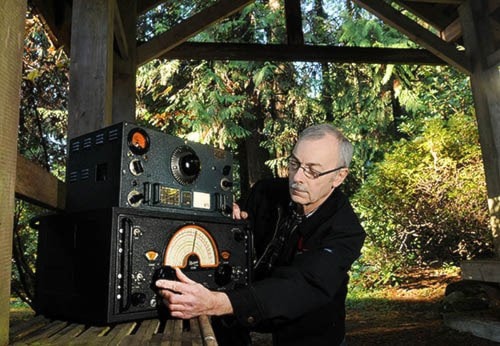The two ancient radios that Tom Brent holds look prehistoric beside a shiny iPhone, with its sleek touchscreen.
But can you repair an iPhone?
Can you fix a modern-day short-wave radio with its circuit boards and microchips?
That’s one of the beefs ham-radio hobbyist Brent has with the new stuff. You just can’t fix it.
“There’s a saying in our hobby that says, ‘Real radios, glow in the dark.’”
That glow comes from the vacuum tubes which light up when on and produce a comforting warmth.
 The dials on the old radios are manual, but capable of fine tuning. And if they ever break down, Brent can pop off the back and fix the odd wire or replace a vacuum tube to get it running again.
The dials on the old radios are manual, but capable of fine tuning. And if they ever break down, Brent can pop off the back and fix the odd wire or replace a vacuum tube to get it running again.
“The old radios that I work on use vacuum tubes. The components are all replaceable or fix-able.”
Brent brought some of the old short-wave radios to the Remembrance Day ceremony at Whonnock community hall to spur interest about those momentous times.
One was a National HRO receiver, made by National Company, Inc., out of Massachusetts.
“At the start of the Second World War, that was the premium interceptor-receiver,” said Brent.
“That was the premier receiver for listening in on the enemy’s activity.”
Brent notes that initially the radio was called HOR, meaning “hell of a rush.”
But someone pointed out that acronym may not sound so nice, so the company switched the letters around.
“That’s how it became an HRO.”
“It was sensitive and you could dial it to frequencies of interest, accurately.”
With invasion a possibility, the Allies wanted to know as much as possible about what the Germans were up to in the Atlantic and what the Japanese were doing in the Pacific Ocean, after war broke out there in December 1941.
The HRO’s tuning ability and reception allowed it to pick up Japanese Morse code transmissions from across the Pacific.
 Unfortunately, he doesn’t know where exactly the radio served its time.
Unfortunately, he doesn’t know where exactly the radio served its time.
But just knowing it was in the war fires the imagination.
“This radio was in the Second World War.
“I wonder where it was? I wonder what it heard – the connection between the radios and the history.”
“This time of year, you think of Remembrance Day.”
What part did this aging piece of electronic spycraft play in defeating the axis forces and ensuring an Allied win?
Unfortunately, only a few items can be traced to a particular ship or station.
“No idea, they could have been anywhere,” Brent said.
Also part of the display was a Canadian Marconi CSR-5. Brent planned to put that and others on display Tuesday along with a Morse code device so that people could hear the tones and even send out a Morse code message themselves.
“If you’re going to have a museum for people, have things that they can touch, because it has far greater impact on them than something behind glass.”
Dozens of listening stations dotted western Canada’s coast and were fitted with such radios to put as many ears as possible on what was going on across  the Pacific.
the Pacific.
Canadian Armed Forces staffed some of those stations, but the federal transportation department also monitored radios.
Much of the listening was done by the Pacific Coast Militia Rangers, composed of men too young, or too old or too frail to serve in the regular forces.
Those were tense times, after the Dec. 7, 1941 Japanese attack on Pearl Harbor in Hawaii. The Japanese later had occupied some of the Aleutian Islands in Alaska, while a submarine shelled Estevan Point, on Vancouver Island.
There was great concern in Canada that the Japanese would soon be on the B.C. Coast.
“That’s part of what put the fear into the population here,” Brent said.
“That’s why it was easy to round up the Japanese Canadians and send them to internment camps. People were scared.”
Most of the communications at that time were done in Morse code, a type of communication that was more clear and less subject to misinterpretation than voice signals.
Morse code functions use only two signals, just like the on-off principle in compute rs. Combinations of dots and dashes, or “dits” and “dahs,” stand for letters, which, strung together, make words.
rs. Combinations of dots and dashes, or “dits” and “dahs,” stand for letters, which, strung together, make words.
“It becomes a language.”
At some point, a Morse code operator would be so skilled, the signals are made automatically.
He notes that young people seem particularly interested in Morse code communication, the initial digital form of communication.
Over the decades, Brent has amassed dozens of others, adding up to more than 70 radios in his shack at home on Dewdney Trunk Road. About half of the collection is former military radios.
“I started when I was nine, and now I’m 64.”
He said being a ham radio operator and collector is a great hobby and wishes his two teenage sons can pick a up a similar activity.
“They come out to the radio shack and say, ‘Dad, you’re such a nerd.’ “
Just as a car enthusiast delights in bringing an old machine auto back to life, so does Brent enjoy giving the old radios ears and a voice again.
And if he spies an old model gathering does somewhere, “There’s always room for one more.”
